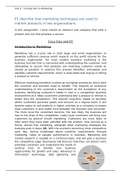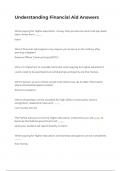Unit 3 – Introduction to Marketing
P1 describe how marketing techniques are used to
market products in two organisations.
In this assignment, I have chosen to research one company that sells a
product and one that provides a service.
Coca Cola and EE
Introduction to Marketing:
Marketing has a crucial role in both large and small organisations to
generate sufficient revenue which impacts on the profit volume for the
business organisation. For most modern business marketing is the
business function that is concerned with understanding the customer, and
attempting to ensure that products are matching customer needs as
closely as possible. In essence this process identifies, anticipates and
satisfies customer requirements, which is associated with buying or selling
a product or service.
Effective marketing therefore involves an exchange process by which both
the customer and business hope to benefit. This requires an extensive
understanding of the customer’s requirement as the foundation of any
business. Identifying customer’s needs is vital in a competitive business
environment as it helps customers understand why a product or service is
better than the competition. This ensures long-term repeat of business
where customers purchase goods and services on a regular basis. It will
become easier to sell products in higher volumes as a company increases
loyal customers. It also builds trust between the business and consumer.
The more loyal the customers become, the less likely the business will
lose to the draw of the competition. Lastly loyal customers will bring new
customers by word-of mouth marketing. Customers are more likely to
refer when they have been satisfied with the product, thus serving as a
bonus, almost free marketing, alongside other marketing strategies the
business puts in place (2). With the economy becoming more competitive
each day, having knowledge about customer requirements through
marketing, helps to elevate performance in business. Marketing and
market research is needed on a continual basis, and will give a business
the competitive edge. Businesses will discover how they can attract more
potential customers and understand the needs of
existing ones to identify new business
opportunities for growth and sales. Advances in
Information technology, data gathering and
,Unit 3 – Introduction to Marketing
analytics are making it possible to understand more of the customers’
needs, through algorithms to personalise their shop (3)(4).
Marketing Mix:
Marketing Mix is a strategy a business will adopt to achieve its aims. This
major tool of marketing is predominately associated with the four P’s:
Product, price, promotion and place. A company, to influence customers
to purchase its products, can control these combination of factors.
What is Ansoffs Matrix?
Ansoffs Matrix is a management tool offering a solution to the growth of a
business by assessing the level of risk – it examines whether to seek
growth, through existing or new products in existing or new markets. The
output of the Ansoffs product/ market matrix sets out strategies, which
sets the direction for the business. It consists of market penetration,
market development, product development and diversification (5)(7).
Coca Cola
In 1886, Pharmacist John
Pemberton stirred up a fragrant
caramel-coloured liquid, which
created a distinctive tasting soft
drink when mixed with
carbonated water. When sampled
by customers, who agreed the
drink was something special, the
pharmacy sold the drink for 5
cents a glass. Pemberton’s
bookkeeper Frank Robinson
, Unit 3 – Introduction to Marketing
named the mixture Coca-Cola, and designed the trademark, distinctive
script that is still used today. Compared to a modest nine sales of glasses
a day, daily servings of Coca-Cola beverages today, are estimated at 1.9
billion globally (8).
Ansoff’s Matrix: Market Penetration:
Market penetration involves selling more of an existing product in an
existing market, normally viable when a market is growing. The strategies
put in place include whether selling more products to established
customers, or finding new customers within these markets – typically by
adapting the ‘Promotion Element’ of the ‘Marketing Mix’.
Coca Cola uses Market Penetration as its primary strategy for growth. Due
to the incredible strength of the brand, the company has been able to
utilize this strategy on an annual basis, by creating a close association
between Coca-Cola and Christmas. Since 1920, the brand uses the iconic
‘Holidays are coming’ adverts and campaigns, Santa Claus adverts,
limited edition bow bottles and the Coca-Cola truck tour to support this
particular strategy. In 1995, the illuminated Coca-Cola Christmas trucks
were introduced for an advertising campaign called “Christmas
Caravans”; Three years later the same
advert had been broadcasted in more than
100 countries, and remains one of the most
widely used Coca-Cola adverts ever
produced. Additionally, the digital
campaign to extend and personalise the
theme of giving a little happiness
introduced an e-commerce platform and
personalised digital greeting cards to
amplify excitement during the festive period. In turn, the business has
dominated the Christmas culture in incorporating the drink as a must-
have during the season; in 2011, Coca-Cola sales reached £185m, where
mince pies and turkeys accounted for only £52m. (9&10)
Ansoffs Matrix: Market Development:
Market Development entails expanding into new markets with existing
products; this includes new markets geographically, new market sectors
and new uses for the products.
Coca-Cola successfully expands into new
markets with a present product. For example,
Coke Zero which was launched in 2005, with a






